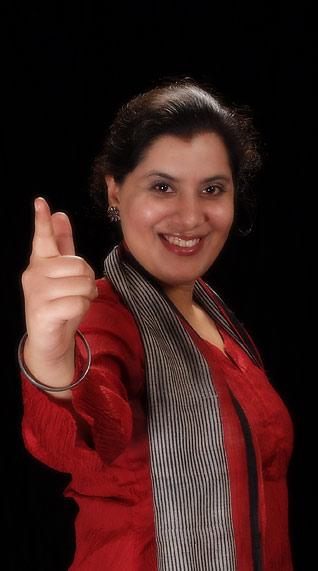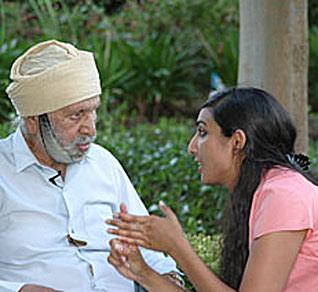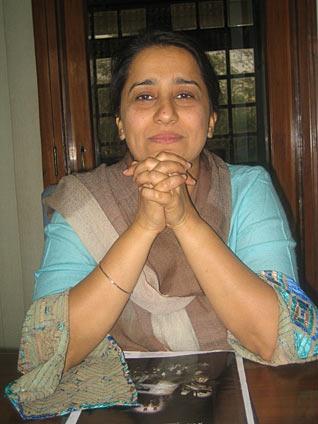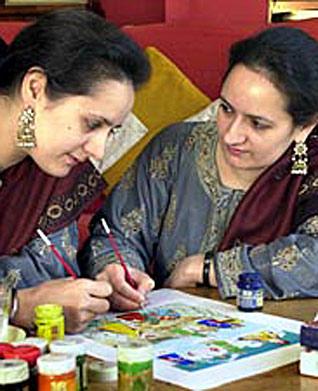
Ish
Amitoj
Kaur
Below: 1st from bottom - artists and filmmakers Amrit & Rabindra Kaur Singh. 2nd from bottom: author and filmmaker Reema Anand. 3rd from bottom: filmmaker Valarie Kaur. Thumbnail: Producer/Director Gurinder Chadha. Home Page: Filmmaker Safina Uberoi.



Columnists
Where Are The Men?
by I.J. SINGH
Mind you, I celebrate wholeheartedly the achievements of young Sikh women today.
That is not at all in question. But there are a few related mystifying matters that I must ask. They baffle me and, at the same time, they elate me.
I was thumbing through the program of the latest New York Spinning Wheel Film Festival, which was recently hosted by the Sikh Art and Film Foundation.
I couldn't help but notice the names of the makers of many of the films exhibited in this venue and in the other Spinning Wheel chapters during the preceding twelve months: Ish Amitoj Kaur, Harpreet Kaur, Amrit and Rabindra Kaur, Harvind Kaur, Valerie Kaur, Reema Anand, Jaskaran Kaur, Mejindarpal Kaur and Shonali Bose.
And I could add to the list, Gurinder Chadha; she stands apart from the others, for she has already made a mark in this genre, has been an articulate analyst and portrayer of Sikh culture, including its apparent contradictions, in the diaspora, and is an established financial success.
Look at the names again. Isn't it so clearly a women's world?
Before you take umbrage at my "hasty" judgment, let me assure you that I am familiar with the Punjabi movies of Harbhajan Singh Mann. He has made several full-length films on themes that are dear to Sikhs (and Punjabis) in the diaspora, particularly those who have successfully carved a niche in the United Kingdom and North America.
I like Mann's work, but it has its limitations. His style is too Bollywood to grab those of us who have lived away from Punjab for almost a lifetime. He also glosses over matters that might have political ramifications back in India. This sensitivity may reflect the realities and the political climate in the mother country.
Also, whenever Mann reaches a defining moment of conflict in the story, he tends to resolve the crisis by the Bollywoodian magic of song and dance. He uniformly dilutes Sikh identity which has, at least outside India, acquired seminal importance for us, for it is under siege so often and in so many places in the world, including India. And his movies are in Punjabi.
I find that Mann's work has greater appeal for the Sikh migrants who came here from Punjab relatively recently, and still feel the pull of their erstwhile homeland. Their offspring, on the other hand, relate to this culture and country as their home and Sikhism as their faith. The more recent the arrival from Punjab, the greater the pull of Harbhajan Mann and his movies.
As far as the children of the migrants are concerned, their connections to the Punjabi culture portrayed by Bollywood and Mann are tenuous at best.
And that brings me back to the question I started with. Why is it that so many of the Sikhs exploring on film the cultural and religious ethos of our Sikh existence in North America and Great Britain are women? Keep in mind, these are mostly young women.
Where are the men? Where did they go?
I suppose for a certain generation, one could presuppose that men were preoccupied with making a living, while women who were largely non-working, or certainly not in driven and competitive careers, had the luxury to cogitate on the everlasting questions of our existence and the meaning of life.
But such facile reasoning is neither sane nor rational - certainly not anymore.
I notice that most of these young women are in highly competitive professions. They are stockbrokers, investment bankers, lawyers, researchers and health professionals. They travel on their jobs as often as men do; they compete with men and women in a society that worships competitiveness. They are as equally educated as their male counterparts. No quarter is asked and none is given them.
Most of these women are not full-time film-makers; their connection to this art form is highly variable, nor is every one a Sikh. But when they make community time, they often veer towards creative arts like film-making and writing. (Just look at this site, sikhchic.com; there are many more women writers and columnists than men.)
Even though much has changed for the better, there is little doubt in my mind that the burden of running a house or raising young children stills falls inequitably on wives and mothers. I say this in spite of the fact that the modern young men are far more likely to share some of the work of the house and family - to a far greater extent than their fathers did in their times.
Yet, I understand an Internet site devoted to women film-makers (http://www.wmm.com/) lists over 500 such women; I am sure this number errs on the low side.
Could it be that women are born storytellers, much better than men? But then, I see that history speaks of legendary storytellers who were almost exclusively men. Just think of Birbal, Kalidas, Aesop, Homer and Shakespeare, for example. Astute readers can supply their own examples from a spectrum of cultures across creation and time.
I suspect that neglect of women storytellers, like the absence of celebrated female chefs, largely reflects male myopia rather than facts on the ground. After all, mothers are the first storytellers, as they orient their growing children to the values and traditions of a family and society. Science suggests that infants who grow up listening to music, lullabies and conversation (stories) might turn out to be smarter and more wholesome adults. And this is a task that is almost exclusively a mother's bailiwick in most cultures. Women also remain the most imaginative chefs, as they struggle to feed a family even when little that is edible is available.
Men, too, are no mean storytellers. Walk into any gathering of men - at a football game or a bar. Their stories are unending and amusing; they can hold listeners spellbound with their tales of the fish that got away or the spin on their skill at golf.
Believe me, I celebrate the well-deserved and emerging prominence of women in the world of cinema. They have claimed the turf, and rightly so. But then, why is the art of film-making in the Sikh diaspora dominated by young women who are largely raised outside Punjab?
I really do not know.
Could it be that it all lies in the genes and that men are really from Mars, while women may indeed be from Venus, or some such friendlier place?
Conversation about this article
1: Tejwant (U.S.A.), September 26, 2007, 3:05 PM.
Bollywood tends to project women as cunning mothers-in-law, adultresses, cheap thrill dancers and in similarly derrogatory roles. The women filmmakers named in this article display the beautiful feminine side of courage, intelligence and perseverance. Their works honour the memory and teachings of Nanak, the Great Feminist.
2: Roma Rajpal (Santa Clara, U.S.A.), September 27, 2007, 1:51 PM.
I think Punjabi movies that are "Bollywood" style, like the ones Harbhajan Singh Mann does, or for example, "Yaara Naal Bhahaaraan", are absolutely wonderful to watch. Many of us watch bollywood movies because that is our cultural background. We are from India, and thus we all see Indian movies. So, whenever I see a well done Punjabi movie made in that same style, I really appreciate that effort! It's awesome...since I get to hear our beautiful language, Punjabi! And, listen to Punjabi songs! Wow! It is a real treat. It is something that tugs at my heart. My parents moved to U.S in the late 70's and we all (parents and all of us sisters) love to see the well-made Punjabi movies. "Waris Shah", for example was another beautifully done movie. I only wish people would make more Punjabi movies that are of high quality and substance: they can be both inspiring and entertaining. Regarding the women in this field now, I think that is marvelous since educated women today, in general all over the world, but more so here, enjoy freedom and their rights to pursue their own goals, their interests, and their "calling". Women by nature are very social, creative, expressive, sensitive and emotional, and that makes them good candidates for the world of movies. Also, there is a lot of power, money and prestige linked to this field and to try and get a chance to achieve that is an incentive for many. Also, in some cases, women have the luxury to experiment and try different careers or options since they may be financially secure. Most importantly, this business is a sort of a gamble and that might be a reason for the absence of men in this field because a man can't afford to "gamble" since most families even today depend on the man of the house for financial stability. Men even today have to carry that burden, which is a huge responsibility.
3: Ruby Kaur (Oxford, England), September 27, 2007, 11:46 PM.
There has been at least one excellent, mature and accomplished movie that has been made about the 1980's tragedy in Punjab, and that is 'Maachis', directed by Gulzar, and starring Tabu, Om Puri and Jimmy Shergill, amongst others. It is a remarkable film about the horrors of that time, and the effect of this on a young man and woman from a village in Punjab who become caught up in the vortex of violence. It is nuanced, complex, deeply absorbing, brilliantly acted and scored, mature and melancholy, and ultimately conveys the unspeakable loss and tragedy of the time in a way that no other movie has done. Compared to the usual lurid melodrama and simplistic style of most Punjabi movies and mainstream Bollywood, it is all the more remarkable, and remains a benchmark for how filmmakers could deal with Punjabi culture and history in an aesthetically mature and distinctive way. Maybe one day a Satyajit Ray will emerge from Punjab.
4: Harminder Kaur (Amritsar, India), October 01, 2007, 8:11 AM.
Very appropriately, you have labeled Harbhajan Mann's films as Bollywoodish. Though Punjabi cinema is revamped recently for depiction of Punjabi culture to a great extent (including the addictions re Whiskey, Scotch and Tharra Desi!), it has also improved in delivering dialogue in Punjabi. But most of the times, it caters to the taste of those who crave for song and dance as the only solution to all conflicts. On top of it all, these film makers have always obliterated the Sikh identity. In this regard, these women film makers deserve to be congratulated for their concern with the community issues and Sikh identity. We feel proud of all these documentary and film makers. "Kambdi Kalaai", in this connection, deserves a special mention. The film focused on Sikh issues which are very close to our hearts. The young director, Ish Amitoj Kaur, has done a good job by picking up and voicing very boldly those untouched issues, without mincing any words. Now, a very pertinent question that has been raised here is: Where are the Men? Where have they gone? They too are there doing their job of a different kind and nature. These women might not have succeeded without their positive support. Moreover, Sir, men like you are out there: you make history with your pen, which is indeed mightier than the sword. As for the themes picked up by these women filmmakers, we must admit that Woman is known to be the Driving Force. As a mother, a wife, a sister, she has always been a forceful impetus. It is the same Soul, full of impetus, that has brought forth these brave women in this field. Moreover, Woman is also known as a story-teller par excellence, who has never forgotten to tag a valuable and wonderful message to the stories that she relates to her progeny.
5: Gurmeet Kaur (Atlanta, U.S.A.), October 01, 2007, 11:16 AM.
Enjoyed reading this article. Somewhere in our historical timeline, we stopped paying attention to various art forms, be it music, visual arts, performing arts or even our traditional architecture. Everyday, we get evidence of it through news regarding our own organizations destroying our heritage buildings and artifacts of extreme historical significance. One possible reason could be that we started focusing too much on financial achievement. Art, however, is work of love and devotion that rarely fetches huge financial rewards. Hence, men who are traditional bread winners, tend to focus on 'financially proven' areas: thus leaving this field to educated women who may have some bandwidth/leeway and tremendous support to tap into their passion. So men are in fact still there, in the background, supporting these women. The term "starving artist" does not exist without a reason. Now it is up to us, the community as a whole, to show our support for these artists, to revive our lost traditions and to make the field lucrative for both men and women alike. "Kambdi Kalai" was a good first step in a much needed field. From what I know, it was a venture solely funded by the director's own family. Ish Amitoj Kaur's new venture, "The Sixth River" is intended to be a larger, full feature, theatrical release. I am anxious to see how the community will support our artists so we can take Sikhi and Punjabi to the next level in the media/theatres. For more info on "The Sixth River", please go to http://www.gurmeetkaur.blogspot.com/
6: Prem Singh (Delhi, India), October 01, 2007, 11:20 AM.
Very interesting question has been raised by Dr.I.J.Singh. Women have definitely overshadowed men in many aspects of film making. Many young amateur women have taken up the cudgels to highlight the issues plaguing the community for a long time now. "The Widow Colony" has once again thrown light on our wounds - the message is loud and clear: we cannot and should not forget the terror unleashed on us in 1984. "Kambdi Kalaai" gave a whole slate of messages. It has shown the path to others and now even Bollywood films like "Kafila" have joined the queue. These women not only mustered the courage but must have spent a fortune in making the non-commercial films for the cause of community. Punjabi film makers among men of today have certainly improved the content but have a void as far as message is concerned. They have gone diagonally opposite and have laid down wrong parameters for the community, like cheap and frivolous comedies, the alcohol culture and turban tying competition amongst those who would never wear turbans. Their sole purpose has been commercial exploitation.
7: D.J.Singh (U.S.A.), October 06, 2007, 2:40 PM.
Our scriptures refer to God as the ultimate Husband and every other individual as HIS bride. We are then taught how a dutiful bride must behave with her husband. In celebrating accomplishments of individuals based on sex, we generate the thought of sexual discrimination. Why not honor just individuals? I am sure the same divine light is present in all, irrespective of sex? Or, may be I am wrong!
8: Gurjeet Kaur (Auburn,Washington, U.S.A.), November 16, 2010, 2:34 PM.
I totally agree with the article and liked the comments as well. I think people are getting sick of what our films are showing now - many of the TV serials are no better. The latest Punjabi movie I saw is 'The Sixth River' ... very nice and not too much of glamour. Has some good messages. I watched it with my family and everybody liked it. Good job, Ish Kaur.


